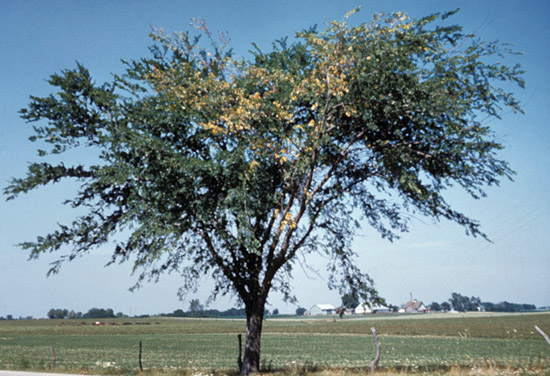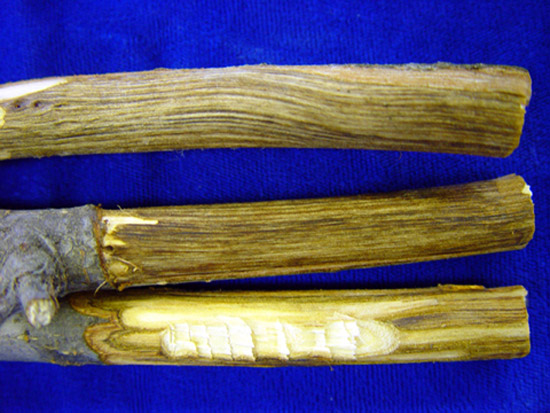Issue 13, July 31, 2009
Dutch Elm Disease or Elm Yellows
There are still many elms in Illinois and many of those are American elms. Each year at the Plant Clinic we culture elm samples for the presence of the Dutch elm disease (DED) fungus. From 2003-2008 there were 84 confirmed cases based on isolations of the causal fungus. In that same time period there were 129 cases where DED was not found.
It is very possible that DED could be involved if your elm exhibits yellowing. Watch for yellowing of the leaves, followed by wilting and browning. Often this happens so quickly that the problem is first noticed when branches with brown leaves appear in the canopy "overnight." A single branch will usually show symptoms first (see first image) with rather rapid spread to adjacent branches and the entire tree. Look for vascular discoloration to help with diagnosis of this disease. DED will cause streaking of the sapwood. Peel back the bark of a symptomatic branch to reveal the brown streaks in the otherwise tan outer sapwood. Verticillium Wilt and Dothiorella Wilt can also cause this streaking in elm but appear infrequently at the Plant Clinic. Positive identification would require laboratory culturing of the fungus. Each of these fungi has distinct structures that can be identified in laboratory cultures. Cut several 8- to 10-inch long sections from wilting, but living, branches that show definite streaking in the sapwood (see second image). The fresh wood sections should be finger thickness and can be sent in plastic or foil to the Plant Clinic for testing. Chilling the wood should not be necessary with Dutch elm suspect samples. Expect about 7 days of lab time for the fungus to grow to the point where it can be positively identified. There is a $15.00 fee for this service. Call 217-333-0519 with questions. It is generally too late to save a tree once it is infected with DED, but an accurate diagnosis of the problem may help save nearby elm trees.


Elm yellows disease is caused by a phytoplasma, an organism that cannot be isolated on agar in a lab. We cannot test for this phytoplasma at the Plant Clinic and must rely on symptoms for diagnosis of this disease. Symptoms of elm yellows may appear any time during the summer but are most common now (mid- to late-summer). Symptoms include yellowing and drooping of foliage followed by leaf drop and death of branches. This pattern may occur on one or a few branches or may quickly involve the entire tree. Susceptible trees may show symptoms over the entire tree in a matter of a few weeks. Tolerant trees become stunted and may develop bunchy, prolific growth at the tips of branches or on the trunk. The inner bark tissues of infected trees often exhibit butterscotch or light brown discoloration in small streaks or flecks. Although trees infected with the Dutch elm disease fungus usually show vascular discoloration in symptomatic branches, the discoloration from elm yellows is not usually in the branches. It is more commonly found in the trunk. A simple field test to help with diagnosis of this disease involves taking a few chips of the stained phloem tissue, placing it in a closed container for a few minutes, and then checking for a wintergreen odor.
I have often wondered whether some of the 129 negative cases mentioned above could be trees with elm yellows. Since we cannot test for the elm yellows phytoplasma, we cannot be certain of anything more than the fact that the DED fungus was not isolated.
As was mentioned last week in the ash yellows article, phytoplasmas can be detected by some laboratories, but at a fairly high cost. One method of proving the presence of a phytoplasma is to find a lab that offers PCR (polymerase chain reaction) testing for phytoplasmas. AGDIA, Inc, a private company in Indiana, has such a service. They offer a nested PCR test for phytoplasmas in general. The cost is currently about $190.00 for the first sample and much less for each additional sample. If you want to know the specific phytoplasma you can add about $50.00 more for a gene sequence to obtain the specific phytoplasma. You will want to contact your testing service of choice before sending a sample.
There is no cure for elm yellows; and infected trees usually die within a year or two. The good news is that elm yellows disease does not move into new areas as quickly as Dutch elm disease. Removal of infected trees is advised in order to remove inoculum sources from the area. Siberian elm seems to be resistant to this disease problem. For additional information about this disease consult Report on Plant Diseases No. 660, Elm Yellows or Phloem Necrosis and its Control. For more information on DED, consult RPD No. 647, Dutch Elm Disease and Its Control.--Nancy Pataky
Author:
Nancy Pataky